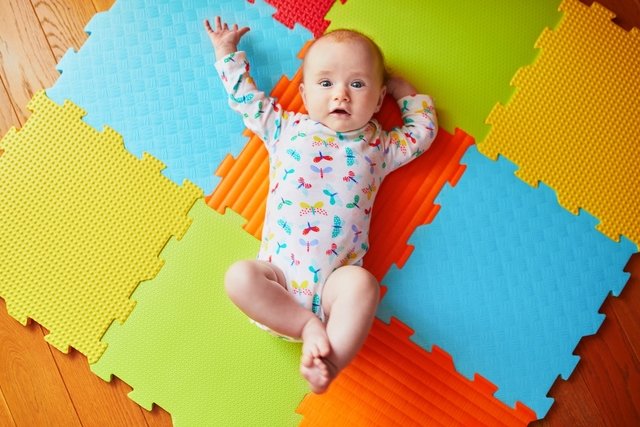3-month-old babies can better recognize the voice and image of their parents, guardians and family members, moving their neck towards people, voices, objects and sounds. Furthermore, when placed face down, babies can usually lift their head, part of their torso and shoulders.
At 3 months, babies develop more facial expressions, smiling at people, in response to stimuli, and can also hit with their hands or grab a toy that is close to them.
The baby’s feeding at 3 months must be with breast milk, exclusively and on demand, which is when the baby wants to breastfeed. However, when the mother is unable to breastfeed, the Brazilian Society of Pediatrics recommends feeding with infant formula, following the pediatrician’s recommendations.
It is important to highlight that each baby is unique and has its own rhythm of growth, sleep, speech and games. Therefore, in cases of doubt about the baby’s development, it is recommended to consult a pediatrician.

Baby weight
The following table indicates the baby’s ideal weight range at 3 months, as well as other important parameters such as height and head circumference, according to the World Health Organization:
If the baby presents values above or below those indicated, it is recommended to consult the pediatrician to assess the child’s development.
Baby sleep
A 3-month-old baby’s sleep normally lasts around 16 hours a day, which can be regular, with long hours of sleep at night. However, some babies may wake up at times during the night due to discomfort, such as hunger or urine or feces in the diaper.
If your baby has the habit of “changing day for night”, it may be interesting to practice a daily “ritual”. Some tips to help your baby get a good night’s sleep include:
It is important to try to maintain the same routine every day before bed, so that the baby gets used to the sleep schedule, which should be continuous and last around 10 hours per night. See more about how long a baby’s sleep should last.
Baby food at 3 months
According to the Brazilian Society of Pediatrics, 3-month-old babies should be fed exclusively with breast milk and on demand, which is whenever the baby wants to breastfeed.
It is important to maintain exclusive breastfeeding until the 6th month, as breast milk offers all the nutrients and water that the baby needs. Furthermore, it is also recommended to offer breast milk, when possible, until the age of 2 or more. Discover all the benefits of exclusive breastfeeding up to 6 months.
In cases where the mother is unable to breastfeed, the Brazilian Society of Pediatrics recommends the use of infant formula, where the type and quantity must be recommended by the pediatrician.
It is worth remembering that babies who are fed infant formula should drink 700 ml of water per day, and it is important to consult their pediatrician regarding the need to offer pure, filtered or boiled water, in addition to that used to prepare bottles. Know the amount of water according to the baby’s age.
Baby development
At 3 months, the baby begins to recognize the voice and appearance of family members better, relating better through their eyes, with smiles and by babbling some sounds.
Because the baby has clearer vision, he can now observe and follow people better with his eyes and by moving his neck. At this age, the baby can also pick up or hit a toy or other object that is close to him with his hand.
Furthermore, when placed face down, the baby is able to lift and control their head and torso better, being able to change from the dorsal position to the prone position. From this stage onwards, care for the baby must be doubled to avoid falls or other accidents.
When to vaccinate your baby
At 3 months, the baby will only need to take the first dose of the Meningococcal C vaccine (conjugate), against the infection caused by the bacteria. Neisseria meningitidis, which can cause severe inflammation in the central nervous system. Find out about the vaccines that your baby should receive according to each stage of life.
Games and activities
Games at 3 months help to stimulate the baby’s cognitive development and increase the bond with parents or guardians and some interesting games are:
- Place the baby on your lap facing the mirror, showing and talking about each part of the body, to help develop the baby’s perception of his or her own image and vision;
- Take the baby for walks in open and airy places, such as squares and parks, preferably before 10:00 or after 16:00;
- Read to the baby, varying the tone of your voice, to help develop hearing and increase the emotional bond;
- Sing calm songs to the baby, fun songs, smiling and looking him in the eyes;
- Give the child toys to pick up with their hands, to encourage knowledge of different colors and textures
When playing with your baby, it is important to give him time to react and respond to the stimulus, as he still has somewhat slow responses at this stage.
Furthermore, toys must be large, without spikes and specific for each age group, to prevent the baby from getting hurt.
Bibliography
- MINISTRY OF HEALTH. Basic care booklet: Child health: growth and development. 2014. Available at: <https://bvsms.saude.gov.br/bvs/publicacoes/saude_crianca_crescimento_desenvolvimento_1ed.pdf>. Accessed on September 28, 2021
- MINISTRY OF CITIZENSHIP. Games and games from popular cultures in Early Childhood. 2019. Available at: <http://www.mds.gov.br/webarquivos/arquivo/crianca_feliz/CartilhaCriancaFeliz_web.pdf>. Accessed on September 28, 2021
- MARIA CECÍLIA SOUTO VIDIGAL FOUNDATION. Fundamentals of child development: from pregnancy to 3 years. 2011. Available at: <http://agendaprimeirainfancia.org.br/arquivos/Fundamentos_do_desenvolvimento%20infantil.pdf>. Accessed on September 29, 2021
- MINISTRY OF HEALTH. National Vaccination Calendar 2020. 2020. Available at: <https://www.saude.go.gov.br/files/imunizacao/calendario/Calendario.Nacional.Vacinacao.2020.atualizado.pdf>. Accessed on September 29, 2021
- BRAZILIAN SOCIETY OF PEDIATRICS. Growth Charts. Available at: <https://www.sbp.com.br/departamentos-cientificos/endocrinologia/graficos-de-crescimento/>. Accessed on September 28, 2021
- FEDERAL UNIVERSITY OF RIO GRANDE DO SUL. Primary care and childcare: growth and development. 2017. Available at: <https://professor.ufrgs.br/danilo-blank/files/casanova_crescimento_e_desenvolvimento_2018.pdf>. Accessed on September 29, 2021
- BRAZILIAN SOCIETY OF PEDIATRICS. How much water do babies and children need to drink?. 2018. Available at: <https://www.sbp.com.br/imprensa/detalhe/nid/qual-a-quantidade-de-agua-que-bebes-e-criancas-precisam-tomar/>. Accessed on September 29, 2021
- MINISTRY OF HEALTH. Girl Child Health Booklet. 2013. Available at: <http://bvsms.saude.gov.br/bvs/publicacoes/caderneta_saude_crianca_menina.pdf>. Accessed on Aug 14, 2020
- MINISTRY OF HEALTH. Boy Child Health Booklet. 2013. Available at: <http://bvsms.saude.gov.br/bvs/publicacoes/caderneta_saude_crianca_menino.pdf>. Accessed on Aug 14, 2020
- LAMARE, Rinaldo. Baby’s life. 42.ed. Rio de Janeiro: Agir Editora LTDA., 2009. 283-337p.
- PINHEIRO Marilene. Infant nutrition . 3rd edition. Brazil: 2005. 246.
- WORLD HEALTH ORGANIZATION. Child growth patterns: Length/height for age. Available at: <https://www.who.int/childgrowth/standards/height_for_age/es/>. Accessed on November 30, 2020
- WORLD HEALTH ORGANIZATION. Child growth patterns: Head circumference for age. Available at: <https://www.who.int/childgrowth/standards/hc_para_edad/es/>. Accessed on November 30, 2020
- WORLD HEALTH ORGANIZATION. Child Growth Patterns: Weight for Age. Available at: <https://www.who.int/childgrowth/standards/peso_para_edad/es/>. Accessed on November 30, 2020

Sign up for our newsletter and stay up to date with exclusive news
that can transform your routine!
Warning: Undefined array key "title" in /home/storelat/public_html/wp-content/plugins/link-whisper-premium/templates/frontend/related-posts.php on line 12
Warning: Undefined array key "title_tag" in /home/storelat/public_html/wp-content/plugins/link-whisper-premium/templates/frontend/related-posts.php on line 13




